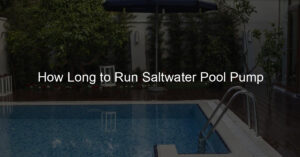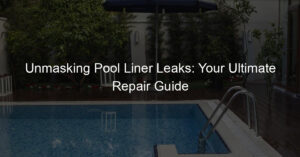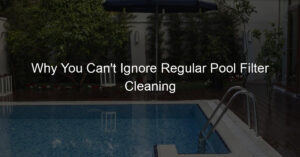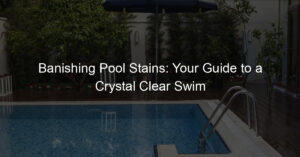Intro
Swimming pools are a fantastic asset, providing a personal oasis for relaxation, exercise, and fun. However, they also demand regular maintenance to ensure their longevity and safety. An often overlooked but necessary part of this maintenance is the process of draining and refilling your pool.
This guide has been designed to provide you with all the knowledge you need on how to effectively and safely drain your swimming pool. Whether you’re a first-time pool owner or looking to take on more of your pool’s upkeep, the following detailed sections will guide you through each step of the process.
Understanding the Need to Drain a Swimming Pool
Your swimming pool isn’t just a static body of water. It’s a dynamic system affected by many factors, including environmental elements, pool usage, and chemical balance. Over time, the water can become saturated with dissolved solids, making it difficult to maintain the right chemical balance, leading to issues such as algae growth or murky water. Regular draining and refilling help to reset this balance, maintaining a healthier, cleaner pool.
Preparation Steps Before Draining Your Swimming Pool
Preparation is key to draining your pool safely and efficiently. Firstly, test the pool water’s pH, chlorine, and total alkalinity levels, which will give you a clear picture of the chemical balance before you start the process. Then, gather all the necessary equipment such as a submersible pump, a garden hose, and protective gear. Ensure you know where the water will be drained to – ideally, it should go to the sanitary sewer or a designated draining area.
Legal and Environmental Considerations for Pool Draining
It’s essential to remember that draining a swimming pool is not as simple as releasing the water into the nearest sewer or yard. Local ordinances often govern the disposal of pool water due to its chemical content. In many places, draining pool water into the street or storm sewer systems is illegal. Always check with your local authorities before proceeding to ensure you are following all necessary laws and guidelines.
Safely Locating and Identifying Your Swimming Pool’s Drain
The location of your pool’s drain will depend on the pool type. In-ground pools usually have a drain at their deepest point, while above-ground pools may have a plug or valve. Before draining, it’s crucial to identify the drain and ensure it’s in good working order. If your pool doesn’t have a drain, or if the drain isn’t functional, a submersible pump will be required.
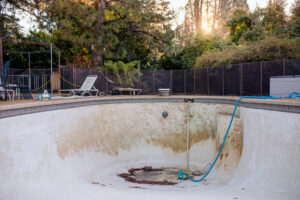
Selecting the Right Pump for Swimming Pool Draining
Choosing the right pump for draining your pool is vital. Submersible pumps are often the preferred choice due to their efficiency and ease of use. These pumps are placed directly into the pool water and pump the water out through a connected hose. When selecting a pump, consider factors such as its power, pumping rate, and whether it is appropriate for the size and type of your pool.
How to Use a Submersible Pump to Drain a Pool
Operating a submersible pump is straightforward but requires careful attention. Start by connecting a hose to the pump’s discharge port, then gently lower the pump into the pool, making sure it’s fully submerged before you start it. Be vigilant while the pump is running – it should never be left unattended, and it’s essential to stop the pump before the water level drops below the pump to avoid damaging it.
The Importance of Pool Water pH Levels Prior to Draining
Before draining your pool, it’s crucial to neutralize the water’s pH level. Pool water often contains chemicals like chlorine, which can be harmful to the environment. By adjusting the pH level to a neutral state (around 7), you reduce the water’s impact on surrounding plants and wildlife. You can easily test and adjust the water’s pH using readily available pool testing kits and chemicals.
Draining an Above Ground Pool: A Comprehensive Guide
Draining an above-ground pool typically involves using a submersible pump or gravity-based draining using the pool’s existing outlet valve. Before starting, ensure you’ve selected a suitable draining location and that the pool water has been appropriately treated to neutralize the pH. Slowly drain the water, monitoring the process continuously to prevent any damage to the pool structure due to sudden water loss.
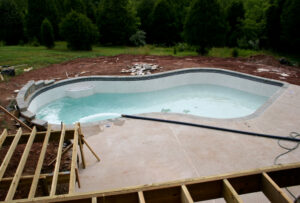
Draining an In-Ground Pool: A Comprehensive Guide
When draining an in-ground pool, a submersible pump is often used, given the absence or inaccessibility of a drain. As with an above-ground pool, start by balancing the pool water’s pH. Set up your submersible pump in the deep end of the pool and begin the draining process. Always monitor the water level, as the pressure from the surrounding soil can damage the pool if it’s drained too quickly.
Preventing Damage When Draining Your Swimming Pool
Draining a swimming pool presents a few risks, notably to the pool’s structure. In-ground pools can suffer from hydrostatic pressure from the surrounding soil when the pool is emptied, potentially causing structural damage or causing the pool to lift out of the ground. Above-ground pools risk wall collapse if the water is drained too quickly. To mitigate these risks, drain your pool slowly and never fully drain an in-ground pool without professional advice.
Proper Disposal of Pool Water: Environmentally Friendly Practices
Pool water disposal should be carried out responsibly to minimize environmental impact. If your local regulations allow it, pool water can be drained into the sanitary sewer via a clean-out port, not via toilets or sinks. This is the preferred method as the water is treated before being reintroduced to the environment. If this isn’t possible, you can drain your pool onto your property, providing it doesn’t run off into neighboring properties or natural water bodies. Always ensure your pool water’s pH is neutral before beginning this process.
How to Refill Your Swimming Pool After Draining: Tips and Tricks
Once your pool is drained and any necessary maintenance has been carried out, it’s time to refill it. Using a regular garden hose, start filling the pool, ensuring that the water is spread evenly throughout the pool to avoid any potential damage. If you live in an area with hard water, consider using a metal sequestrant to prevent staining. Once filled, balance the pool chemicals starting with pH, then alkalinity, and finally, sanitizer levels.
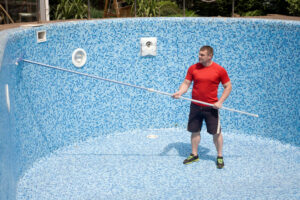
Post-Draining Pool Maintenance: Ensuring Optimal Water Quality
After refilling your pool, ongoing maintenance is crucial to keep the water safe and clear. This includes regular chemical testing and adjustments, as well as frequent cleaning. Pay special attention to the pool in the weeks following a drain and refill, as it may take some time for the chemical levels to stabilize.
Troubleshooting Common Problems in the Pool Draining Process
While draining a pool is a relatively straightforward process, problems can arise. If your pump isn’t working efficiently, check for blockages in the intake or the hose. If your pool’s water isn’t clearing after a drain and refill, recheck the chemical balance and consider whether the water source might contain impurities. Always consult a professional if you’re unsure about any aspect of the draining process.
The Role of Professionals in Swimming Pool Draining: When to Hire Help
While many aspects of pool maintenance can be carried out by the pool owner, there are times when professional help may be needed. Complex issues such as persistent water cloudiness, major repairs, or concerns about the structural integrity of the pool when draining, are all signs that it’s time to call in the experts. Professional pool services have the toolsand knowledge to handle these issues efficiently and safely, helping to maintain your pool in the best condition possible.
How Often Should You Drain a Swimming Pool? An Expert’s View
How often to drain and refill your pool can vary based on factors like pool usage, the chemical balance, and local climate. As a general rule, most professionals recommend draining and refilling your pool every 3-7 years. However, if your pool’s water is consistently murky or the chemical levels are difficult to maintain, it might be time for a drain and refill.
Avoiding Potential Pitfalls in Pool Draining and Maintenance
Prevention is better than cure, especially when it comes to pool maintenance. Regularly test and adjust your pool’s chemical balance to prevent issues that could necessitate a draining. Ensure that your pool’s drainage system, whether that’s a built-in drain or a submersible pump, is in good working order and ready to use when needed. Most importantly, don’t rush the draining process – taking it slow is essential to prevent potential damage to your pool.
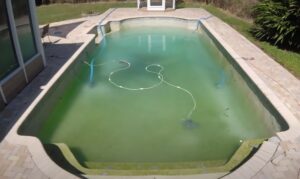
Rebalancing Pool Chemicals After Draining and Refilling
Once you’ve refilled your pool, it’s vital to rebalance the water chemicals. This typically involves testing the water and adjusting the levels of pH, alkalinity, and sanitizers as needed. It’s important to give the water some time to circulate after each adjustment before testing again and adding more chemicals if necessary.
FAQs: Answering Your Questions about Pool Draining
Despite detailed guides, pool owners often have specific questions regarding their unique situations. We’ve collated the most frequently asked questions and provided answers to assist you. If your question isn’t covered, consider consulting a pool maintenance professional or your local pool supply store for further guidance.
Case Study: Real-Life Examples of Effective Swimming Pool Draining
Case studies can provide valuable insight into the practical application of pool draining and the potential issues that might arise. By examining real-life scenarios, pool owners can better understand the process and how to respond to unexpected situations. These studies highlight the importance of preparation, the correct use of equipment, and careful monitoring throughout the process.
Quick Guide to Pool Draining and Refilling
| Step | Task | Tips | Timeframe |
|---|---|---|---|
| 1 | Testing water | Use a reliable pool testing kit | Immediately before draining |
| 2 | Preparing equipment | Gather a submersible pump, hose, and protective gear | Before starting |
| 3 | Draining the pool | Monitor the process closely to prevent damage | Duration varies based on pool size and pump rate |
| 4 | Refilling the pool | Use a regular garden hose and spread the water evenly | Immediately after draining |
| 5 | Rebalancing chemicals | Start with pH, then alkalinity, then sanitizers | After refilling and allowing water to circulate |
Conclusion
Draining and refilling your swimming pool is an essential aspect of pool maintenance, contributing significantly to the health of your pool and the enjoyment you get from it. Although it might seem intimidating, with the right preparation and care, it’s a task that many pool owners can undertake themselves. Remember, every pool is unique, so always take into account your pool’s specific needs and circumstances. If in doubt, don’t hesitate to seek professional advice to ensure your pool stays in the best possible condition.
Digging Deeper: Aspects Beyond the Surface
The Impact of Weather on Your Pool Draining Schedule
Weather plays a significant role in when and how you should drain your pool. In colder climates, pools are often drained and covered for the winter to prevent damage from freezing temperatures. Conversely, in hotter climates, high evaporation rates can concentrate chemicals and impurities in the water, necessitating more frequent draining.
Understanding the Impact of Heavy Usage on Pool Water Quality
Heavy usage of your swimming pool, whether from large family gatherings or frequent pool parties, can significantly impact the water quality. This is due to increased levels of contaminants like body oils, sunscreen, and sweat, which can strain the pool’s chemical balance and filtration system, potentially requiring more frequent water replacement.
The Role of Your Water Source in Pool Health
The quality of the water used to fill your pool can greatly affect the water’s chemical balance and clarity. If your water source is high in minerals or other contaminants, it may make maintaining your pool more challenging. In these cases, you may need to use additional treatments or consider using a different water source.
How Regular Maintenance Can Extend Time Between Drains
Regular maintenance, such as consistent chemical balancing, regular cleaning, and prompt repair of any issues, can extend the time between necessary pool drains. By maintaining a healthy pool, you’re not only creating a more enjoyable swimming environment but also prolonging the lifespan of your pool and its equipment.



